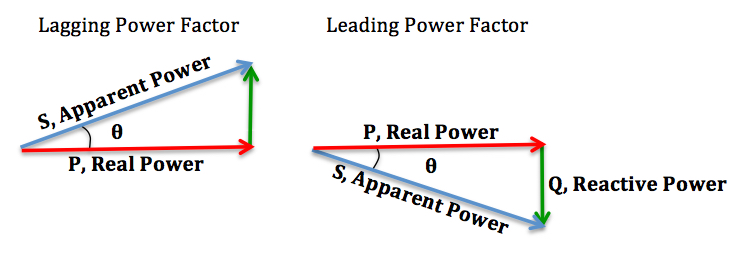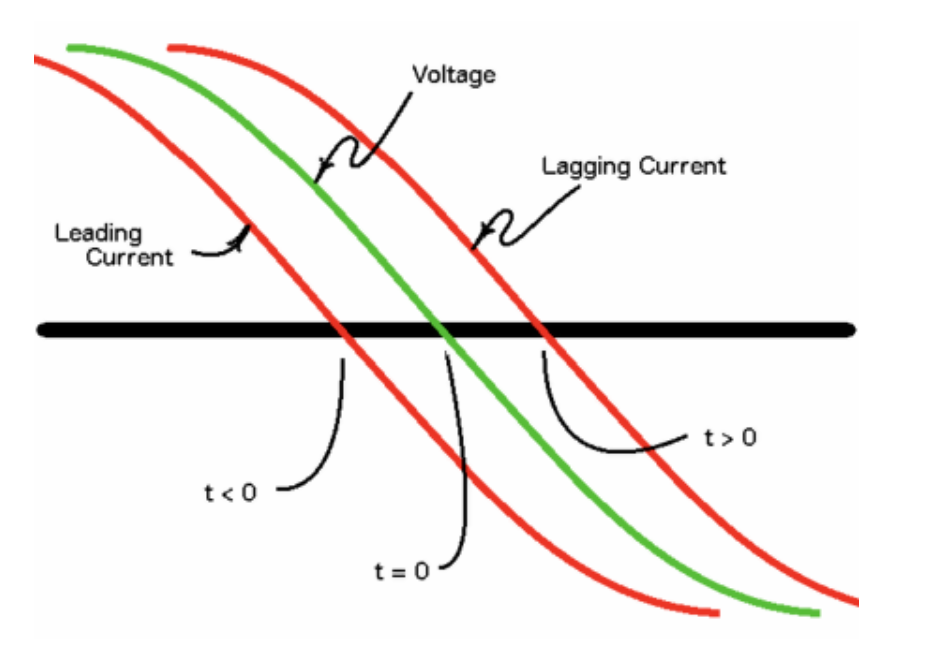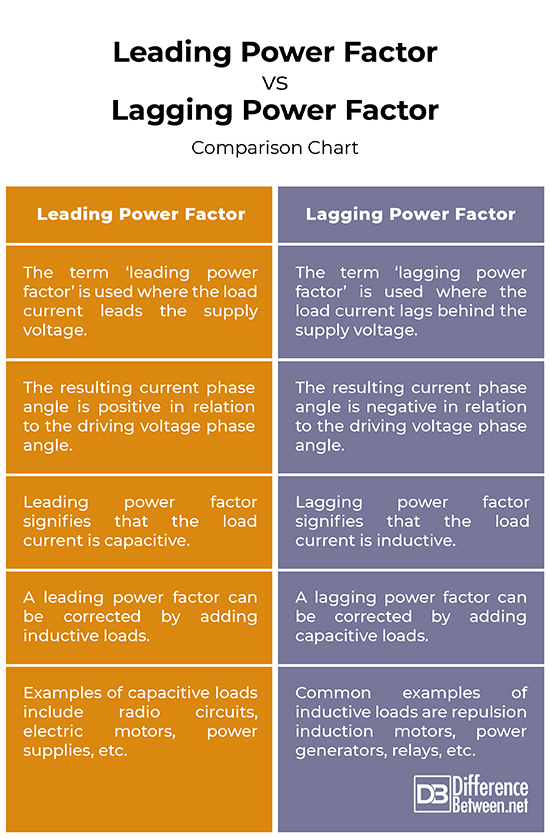Difference Between Leading and Lagging Power Factor
The term “power factor” is commonly used with regard to both single-phase and three-phase AC circuits. In DC circuits, regardless of the type of load, power can be determined simply by multiplying the readings of a voltmeter and an ammeter together. However, in resistive-reactive AC circuits, the product of the supply voltage and the load current gives you the apparent power of the load, but not its true power. To determine its true power, a wattmeter must be used, in practice, to measure the true power by monitoring the supply voltage together with the in-phase component of the load current. The ratio of active power to apparent power in AC circuits is called the “power factor” of the load.
Power factor = True power/Apparent power
Power factor is always between 0 and 1 and can be determined by the lead or lag of current with regard to voltage. The terms ‘leading’ and ‘lagging’ refer to where the load current phasor lies in relation to the supply voltage phasor. They are determined by the sign of the phase angle between the current and voltage waveforms. Capacitive loads will, therefore, cause a leading power factor, whereas inductive loads will cause a lagging power factor. Power factors are often stated as leading or lagging. Let’s take a look at the differences between the two.
Lagging Power Factor
The term ‘lagging power factor’ is used where the load current lags behind the supply voltage. It is a property of an electrical circuit that signifies that the load current is inductive, meaning inductive loads will cause a lagging power factor. In this regard, a lagging power factor can be corrected by adding capacitive loads. Common inductive loads include repulsion induction motors, which represent the most common form of three-phase motors and which always have a lagging power factor. Lagging power factor can be formally described as the current that reaches its peak value up to 90 degrees later than the voltage. All AC motors (except overexcited synchronous motors) and transformers operate at lagging power factor. Simply put, if the load is inductive then the power factor is lagging.
Leading Power Factor
For capacitive circuits, where the load current leads the supply voltage, the term ‘leading power factor’ is used. It is a property of an electrical circuit that signifies that the load current is capacitive, meaning capacitive loads will cause a leading power factor. In this regard, a leading power factor can be corrected by adding inductive loads. A leading power factor means that the same terminal voltage can be maintained with a lower internal induced voltage. The power factor of a leading current is sometimes called a positive power factor. It can be formally described as the current that reaches its peak value up to 90 degrees ahead of the voltage. Simply put, if the load is capacitive then the power factor is leading.
Difference between Leading and Lagging Power Factor
Definition
– Power factor can be stated as leading or lagging to show the sign of the phase angle between the current and voltage waveforms. The term ‘lagging power factor’ is used where the load current lags behind the supply voltage. It is a property of an electrical circuit that signifies that the load current is inductive. For capacitive circuits, where the load current leads the supply voltage, the term ‘leading power factor’ is used. It is a property of an electrical circuit that signifies that the load current is capacitive. So, capacitive load are leading whereas inductive loads are lagging.
Visualization
– The following graph shows a voltage with a leading and lagging current, plotted against time. The lagging current line represents a lagging current with a negative phase angle and a power factor less than 1, whereas the leading current line represents the leading current with a positive phase angle and a power factor less than 1. The leading current will reach its peak value before the voltage reaches its peak, where as the lagging current will reach its peak value after the voltage reaches its peak.
Leading Power Factor vs. Lagging Power Factor: Comparison Chart
Summary
The terms ‘leading’ and ‘lagging’ refer to where the load current phasor lies in relation to the supply voltage phasor. They are determined by the sign of the phase angle between the current and voltage waveforms. The term ‘leading power factor’ is used where the load current leads the supply voltage, whereas the term ‘lagging power factor’ is used where the load current lags behind the supply voltage. A leading power factor signifies that the load current is capacitive in nature whereas a lagging power factor signifies that the load current is inductive. In this regard, a leading power factor can be corrected by adding inductive loads and a lagging power factor can be corrected by adding capacitive loads.
- Difference Between Caucus and Primary - June 18, 2024
- Difference Between PPO and POS - May 30, 2024
- Difference Between RFID and NFC - May 28, 2024
Search DifferenceBetween.net :
3 Comments
Leave a Response
References :
[0]Curtis, Peter M. Maintaining Mission Critical Systems in a 24/7 Environment. Hoboken, New Jersey: John Wiley & Sons, 2011. Print
[1]Waygood, Adrian. An Introduction to Electrical Science. Abingdon, United Kingdom: Routledge, 2013. Print
[2]Fleckenstein, Joseph E. Three-Phase Electrical Power. Boca Raton, Florida: CRC Press, 2017. Print
[3]Image Credit – https://en.wikipedia.org/wiki/Leading_and_lagging_current
[4]Image credit: https://commons.wikimedia.org/wiki/File:Lagging-Leading.jpg




Please send to my email any technical subject
thank very much
you really helped me
Any summarised statistics notes with examples